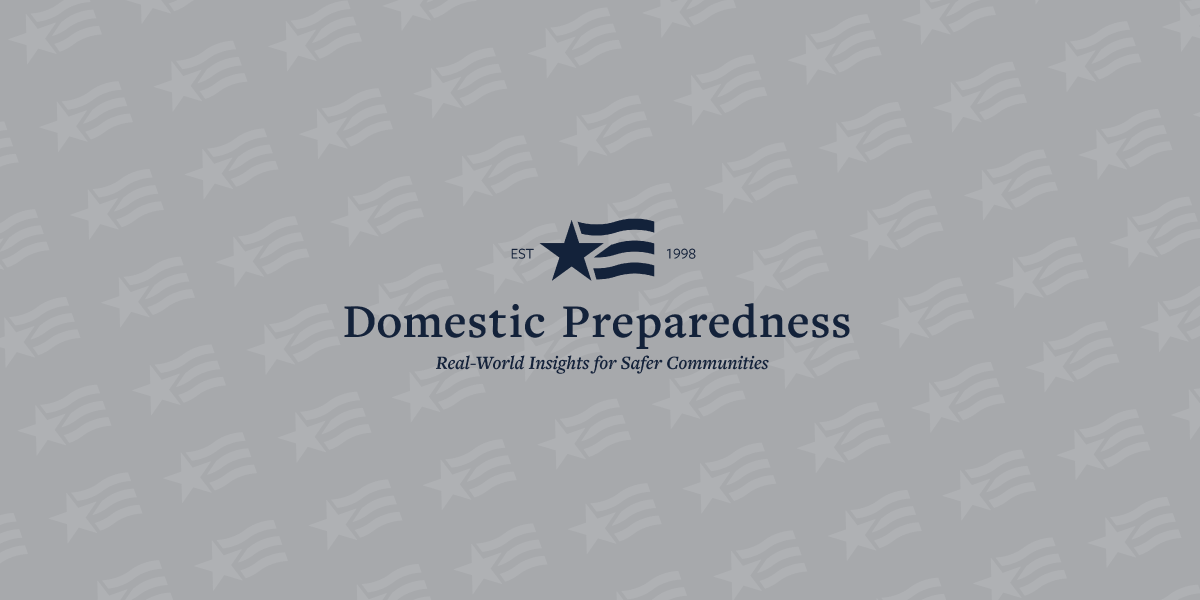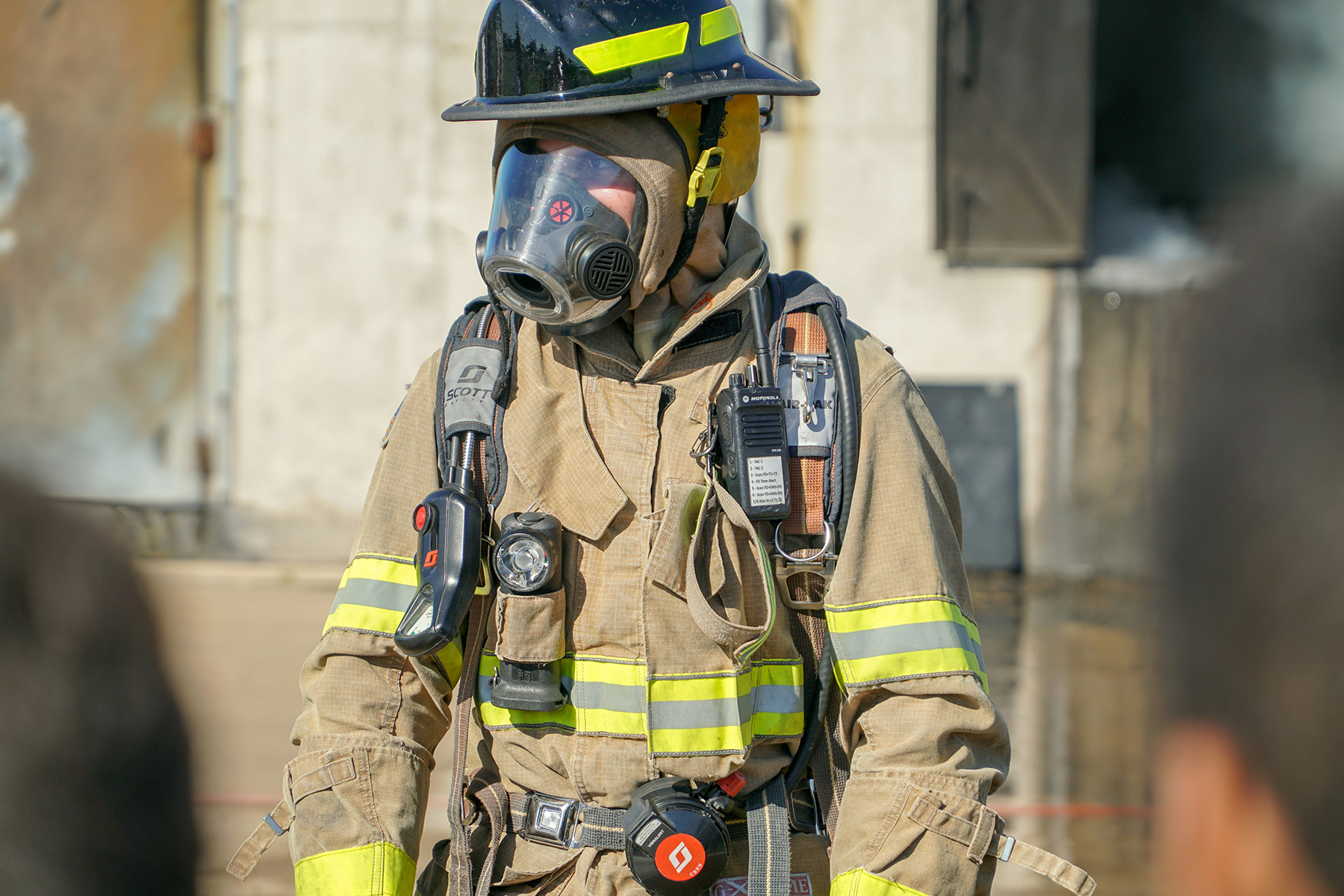Most recently published

WebEOC Fusion for Disasters and Everyday Use
Joseph Cahill
May 7, 2008
Flexibility, versatility, and a quantum upgrade in overall capabilities are the biggest selling points of ESi’s newest WebEOC system, unveiled last month at the company’s fourth annual User Conference in Boston.

Proactive Standards Development for Emergency Responders
Diana Hopkins
April 23, 2008
Anything worth doing is worth doing well – and in accordance with established standards not only acceptable to experienced professionals but also recognized by the community at large as both valid and necessary.

Mass-Fatality Management Planning – A Hospital Perspective
Craig DeAtley
April 23, 2008
Most U.S. hospitals & other healthcare facilities focus their efforts on saving lives & helping those who are seriously injured. The handling of the dead, sometimes a large number at the same time, is a different but almost equally important skill.

The Myth of the Cordon Sanitaire
Michael Allswede
April 16, 2008
The operational as well as theoretical concept of the “cordon sanitaire” – a French phrase literally translated as “quarantine line” – is one of containment. Originally, cordon sanitaire referred to the segregation of persons suffering from communicable and untreatable diseases from their healthy fellow citizens through use of a physical

Debris Recycling – Transforming Disasters Into Opportunities
Kirby McCrary
April 16, 2008
After the storm comes the rainbow. Supposedly. After a disaster comes the debris – and the problem of what to do with it. Surprisingly, perhaps, there are some profitable solutions that should be considered.

Resource-Typing Implications for EMS and Emergency Management
Joseph Cahill
April 9, 2008
Attention to detail is frequently the principal difference between the success, or failure, of any human endeavor. That is particularly true in times of sudden disaster, when “mere words” – precisely expressed – may have life-or-death implications.

The Creation of a Home Guard for Domestic Preparedness
Lawrence J. Korb and Ian Moss
April 2, 2008
At a time when defense of the U.S. homeland is a major concern, the National Guard is playing a much-increased role in U.S. operations overseas. The best way to fill the capabilities gap is to establish a non-deployable Home Guard under the Department.

The Gateway Key to Synergistic Communications
Stephan Macke
March 26, 2008
Thanks to mutual-aid compacts between neighboring political jurisdictions, first-responder cooperation at mass-casualty incidents is often a multi-agency effort. But before the agencies can work together they must first be able to speak the same language.

Greater Responsibilities, More Recognition for Hospital Emergency Managers
Theodore Tully
March 19, 2008
The healthcare failures during and in the aftermath of Hurricane Katrina received more publicity than the many unpublicized successes. Nonetheless, a new look at hospital emergency management was obviously needed, and is now well underway.

Incident Action Plans for Hazmat/WMD Incidents
Glen Rudner
March 12, 2008
A quick but accurate analysis of unknown but potentially lethal agents detected by first responders at the scene of a mass-casualty incident can save many, many lives. That analysis requires skill, knowledge, and state-of-the-art analytical equipment.

Partnerships at Work in Public Health Planning
Steven Harrison
March 12, 2008
The Commonwealth of Virginia once again provides a best-practices example of the best way to plan for a potential mass-casualty disaster: Ensure that all stakeholders, private-sector as well as government, are fully involved ahead of time, and practice.

Force Protection – First, Protect the Protectors
Joseph Cahill
March 5, 2008
Not enough masks and/or medical supplies – those shortages can be overcome. But when there are not enough EMTs or paramedics, or if those who are available are among the early victims, there is no quick and easy way to find replacements.

Fleet Decontamination During a Pandemic
Joseph Cahill
May 14, 2008
Decontamination, disinfection, and the use of liquid hand cleaners – all are among the most important “weapons” in the first-responder community’s fight against a potential flu pandemic. And it’s a battle to the death. Literally.

WebEOC Fusion for Disasters and Everyday Use
Joseph Cahill
May 7, 2008
Flexibility, versatility, and a quantum upgrade in overall capabilities are the biggest selling points of ESi’s newest WebEOC system, unveiled last month at the company’s fourth annual User Conference in Boston.

Proactive Standards Development for Emergency Responders
Diana Hopkins
April 23, 2008
Anything worth doing is worth doing well – and in accordance with established standards not only acceptable to experienced professionals but also recognized by the community at large as both valid and necessary.

Mass-Fatality Management Planning – A Hospital Perspective
Craig DeAtley
April 23, 2008
Most U.S. hospitals & other healthcare facilities focus their efforts on saving lives & helping those who are seriously injured. The handling of the dead, sometimes a large number at the same time, is a different but almost equally important skill.

The Myth of the Cordon Sanitaire
Michael Allswede
April 16, 2008
The operational as well as theoretical concept of the “cordon sanitaire” – a French phrase literally translated as “quarantine line” – is one of containment. Originally, cordon sanitaire referred to the segregation of persons suffering from communicable and untreatable diseases from their healthy fellow citizens through use of a physical

Debris Recycling – Transforming Disasters Into Opportunities
Kirby McCrary
April 16, 2008
After the storm comes the rainbow. Supposedly. After a disaster comes the debris – and the problem of what to do with it. Surprisingly, perhaps, there are some profitable solutions that should be considered.

Resource-Typing Implications for EMS and Emergency Management
Joseph Cahill
April 9, 2008
Attention to detail is frequently the principal difference between the success, or failure, of any human endeavor. That is particularly true in times of sudden disaster, when “mere words” – precisely expressed – may have life-or-death implications.

The Creation of a Home Guard for Domestic Preparedness
Lawrence J. Korb and Ian Moss
April 2, 2008
At a time when defense of the U.S. homeland is a major concern, the National Guard is playing a much-increased role in U.S. operations overseas. The best way to fill the capabilities gap is to establish a non-deployable Home Guard under the Department.

The Gateway Key to Synergistic Communications
Stephan Macke
March 26, 2008
Thanks to mutual-aid compacts between neighboring political jurisdictions, first-responder cooperation at mass-casualty incidents is often a multi-agency effort. But before the agencies can work together they must first be able to speak the same language.

Greater Responsibilities, More Recognition for Hospital Emergency Managers
Theodore Tully
March 19, 2008
The healthcare failures during and in the aftermath of Hurricane Katrina received more publicity than the many unpublicized successes. Nonetheless, a new look at hospital emergency management was obviously needed, and is now well underway.

Incident Action Plans for Hazmat/WMD Incidents
Glen Rudner
March 12, 2008
A quick but accurate analysis of unknown but potentially lethal agents detected by first responders at the scene of a mass-casualty incident can save many, many lives. That analysis requires skill, knowledge, and state-of-the-art analytical equipment.

Partnerships at Work in Public Health Planning
Steven Harrison
March 12, 2008
The Commonwealth of Virginia once again provides a best-practices example of the best way to plan for a potential mass-casualty disaster: Ensure that all stakeholders, private-sector as well as government, are fully involved ahead of time, and practice.
Hospital Emergency Management: The Anatomy of Growth
Theodore Tully
February 27, 2008
Prior to 11 September 2001 the term “emergency management” was more an abstract theory than an operational mandate. Today it is a full fledged profession, particularly in hospitals & other medical facilities, so must be factored into all major planning.
TVA and Protection of the Critical Infrastructure
Adam Montella
February 20, 2008
The Tennessee Valley Authority is basically a huge and highly successful mega-corporation that has to deal with private-sector funding and operational realities while also adhering to federal, state, and local rules and regulations.
Public-Health Planning: Partnerships Work
Steven Harrison
February 13, 2008
The Commonwealth of Virginia provides another best-practices example – this time in the public-health field – of how private-sector organizations can work with one another, and with their government counterparts, before rather than after a crisis erupts.
Gap Analysis – A Long and Winding Process
James M. Rush Sr.
February 13, 2008
Disaster planning is difficult, time-consuming, sometimes boring – but also absolutely necessary. And in the long run it conserves resources, permits the most efficient use of the usually limited medical staff available, and saves a lot of lives.
Anatomy of a Near-Miss Radiation Disaster
Michael Allswede
February 6, 2008
The 2006 assassination of former KGB Colonel Alexander Litvenenko was eventually solved – but there are many questions still unanswered as well as strong suspicions about the operating tactics of Russia’s post-USSR political leaders.
A Burning Question: National Fire Insurance?
Joseph Cahill
February 6, 2008
The almost pandemic outbreak of wildfires in California & other western states last year has aroused interest in a sometimes proposed but never authorized partial solution: enactment of a federally subsidized program to help high-risk communities.
Thomas J. Lockwood, Senior Advisor, DHS Office of Screening Coordination
John F. Morton and Thomas J. Lockwood
January 30, 2008
How does the department manage, and reconcile, the complex and politically difficult task of identification security with privacy needs, site-access requirements, and the National Incident Management System process?
Business and Personal Preparedness – the Key to Collective Survival
Adam Montella
January 23, 2008
Small businesses have big problems – during and in the aftermath of incidents causing damage to their facilities, inventories, and supply chains. The Homeland Security & Defense Business Council recognizes the problem & is doing something about it.
The Management of Mass-Fatality Incidents
August Vernon
January 16, 2008
Reverence, respect, professional expertise, and detailed planning – all are among the essential tools needed by state and local planners to successfully deal with the aftermath of a major disaster causing a large number of deaths and injuries.
Moulage Casts Reality With Mock Injuries
Shannon Arledge
January 16, 2008
An ancient & honorable Renaissance word is put to good use at FEMA’s Center for Domestic Preparedness, where moulage artists replicate broken arms, cuts, bruises, & other injuries to make first-responder training more realistic and more effective.
Regional Hospital Coordination: Common Sense Made Mandatory
Theodore Tully
January 9, 2008
Private-sector U.S. hospitals are finding out that working more closely with one another in the new Age of Terrorism, as now required by law, is not only a prudent policy but also a sound business practice as well.
EMS Operations at Alternate-Treatment Vaccination Centers
Joseph Cahill
January 2, 2008
In a mass-casualty incident involving the rapid spread of dangerous diseases the most effective immediate defense will be a massive vaccination program. But who will do the vaccinating? No one knows for sure.
Follow Us
Get Instant Access
Subscribe today to Domestic Preparedness and get real-world insights for safer communities.


